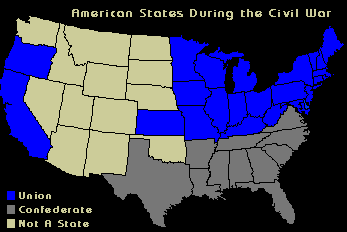
The American Civil War provided many documents which have information vital for those interested in family history. Many men born from 1825 to 1847 served in the armies, but many older men and some young boys also participated. In addition, draft reg istration provides records of others in that age group who did not serve.
Each of these books gives detailed information and sources to aid your research.
In most cases, to use other sources you must know the state and the unit in which the soldier served because I have found no complete listing of all soldiers. Here is an outline some ways to find out the state and unit for your soldier.

Alabama Georgia N. Carolina Texas
Arkansas Louisiana S. Carolina Virginia
Florida Mississippi Tennessee
Kentucky* Missouri*
* Kentucky and Missouri were represented by stars on the Confederate flag
and had representation in the CSA. However, the pre-war governments of
these states never seceded from the Union. Reports suggest that over
twice as many soldiers from Kentucky served with the Union than with the
Confederacy [Wooster, R. A., The Secession Conventions of the South, 1962,
Princeton, NJ].
However, there were units in the Union Army from all of the states of the CSA.
The states not listed above remained in the Union. West Virginia was admitted as a Union state in June 1863.
[Kentucky and Missouri remained in the Union, though both were represented in the CSA].
However there were units in the Union Army from all states of the Confederacy and
soldiers from Union states sometimes joined the Confederate army. One famous example is the Orphan
Brigade of Confederate soldiers from Kentucky.
Note: Some of the states which remained in the Union had been slave states. For example, Kentucky and Missouri.
The briefest regimental histories generally list the major engagements of the regiment and things which make the regiment unique. For some regiments, entire books have been written.
Short Regimental Histories
Pension applications resulting from Civil War service often contain family information and can be useful for genealogists.
Many soldiers, widows, and children received pensions from the government following the war. For soldiers who served the Union, the pensions were paid by the U.S. Government. For soldiers who served the Confederacy, pensions were paid by some of the Confederate states.
UNION----Pensions from the U.S. Goverment were issued to Union veterans and the files are maintained by the National Archives in Washington, D.C. The files have not been microfilmed and are available only through in-person or by-snail
-mail research. Pension files may be obtained for a fee from the National Archives and Records
Administration at the address below. Information should be submitted on NATF Form 80, which can be obtained from:
General Reference Branch (NNRG-P)Although the forms must be sent by regular mail, blank forms may now be requested by e-mail. How to order blank NATF forms by e-mail.
National Archives and Records Administration
7th and Pennsylvania Ave, N.W.
Washington, DC 20408
Additional information about records in the National Archives can be found at the site maintained by the National Archives and Records Administration.
CONFEDERATE----Pensions for Confederate veterans were issued by some former Confederate states, including Tennessee and Texas. Most of these are maintained within the state's archives.
A useful reference:Confederate research sources : a guide to archive collections
by Neagles, James C. [1986] Salt Lake City, UT : Ancestry Pub.
Contact the webmaster
Web Hosting donated by: Infobahn Outfitters, Inc.
This document: http://legacy.outfitters.com/illinois/history/civil/cwgeneal.html
Last update: Monday, 07-Jun-1999 11:02:18 CDT